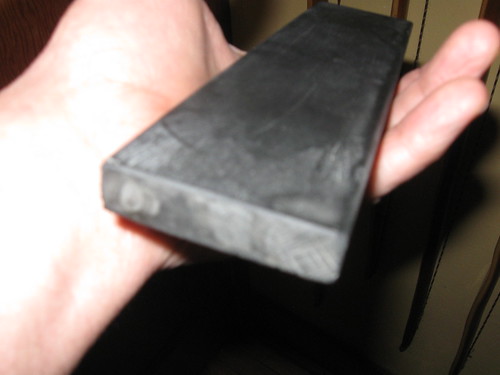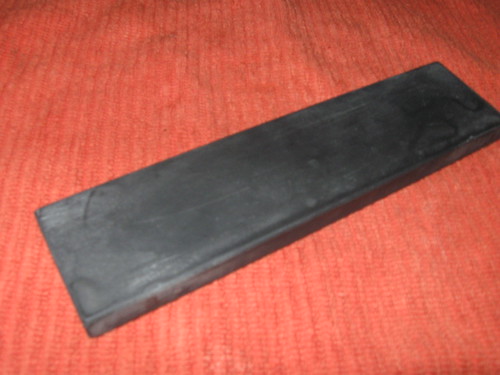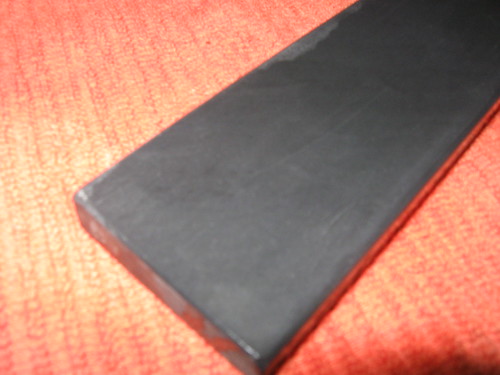[The second half of this post has been edited following a very helpful email reply from Roger at Inigo Jones Slate Works.]
Let's have a look at what I think is the only other UK stone type I have at the moment - the rather pretty aqua-coloured stone in the first post, that I said might possibly be a type of Glanrafon:
Since then I managed to score myself a Glanrafon, as talked about above, and in use the stones
are similar enough that they could be variations of the same, though they are a little different. On getting back to Australia I discovered a couple of interesting things: Firstly I had my USB scope again so looked at them together. And though similar, I don't believe this stone to be precisely a type of Glanrafon.
The second, perhaps
more interesting, thing I discovered about this stone... was that I already had one:
The smaller stone was a find on Australian ebay find in the middle of last year. At the time I asked a bit about it, but no one seemed to know what it was, and after that I didn't pay much attention to it, as I hadn't then started honing razors, and it was too hard and fine to be much use on a knife.
And I hadn't really noticed the patterns and colour on the stone as they're more noticeable when wet, and less pronounced on the smaller version. This is what they look like dry:
Both stones also have a distinctive rippled pattern on one side, that looks a little like running water:
A combination of hunch, and having a bit of experience with this kind of thing meant I was relatively certain that, like the Glanrafon, these stones were Welsh. There are number of historic stone quarries in a relatively small area of Snowdonia in northern wales. These were largely for slate, though the novaculite Idwal stone is from the same area and in fact displays some slate-like qualities to it, suggesting to me it was formed though metamorphosis of an original similar slate to this and the Glanrafon stone. Others from this area are the various types of Llyn Melynllyn or Yellow Lake Oilstone, the legendary and mysterious Cutler's Green, and also the Dragon's Tongue which as far as I know is the only UK natural whetstone still being produced by a commercial company.
And it was the latter who I emailed earlier today with some pictures, and were able to shed some light on the origins of this beautiful blue-green stone:
'The Greener stones come from the Nantlle Valley where there used to be several quarries operating but now all closed, one quarry was called the Dorothea quarry and that slate might have come from there.'
The Nantlle Valley (Dyffryn Nantlle) is in the west of Snowdonia National Park, set around a lake of the same name - Llyn Nantlle. What was particularly interesting about this news is that the Glanrafon quarry lies just to the north of the small village of Rhyd-Ddu, which is at one end of the Dyffryn Nantlle. So if this blue-green stone isn't actually the same exact stone as the Glanrafon, then it is at least the same kind rock, and likewise found in the immediate vicinity around Lake Nantlle. I'm going to call this stone the
Llyn Nantlle.*
The Llyn Nantlle is a very hard, fine-grained slate, finishing considerably north of 10k. Like the Glanrafon it's a slow stone, thought perhaps the LN is marginally quicker, as well as being a touch finer. In terms of knives it would be too fine and hard for anything but the final finishes of a yanagiba, or deburring a coarser finish. It will not polish a bevel well.
Despite this the LN is among my very favourite stones: It's very pretty to my eye. It's rare - I only know of one other person who has this stone. And it's a superb razor finisher - right up there with the best Idwals and Charnley Forests in terms of UK razor hones.
---
* As I think I pointed out before on this thread - Welsh names like this can be rather difficult for a lot of people (myself included) to pronounce properly, as it involves sounds that are not used in the English language. But if you wanna give it a go... this is how to say
Llyn and
Nantlle in Cymraeg.































